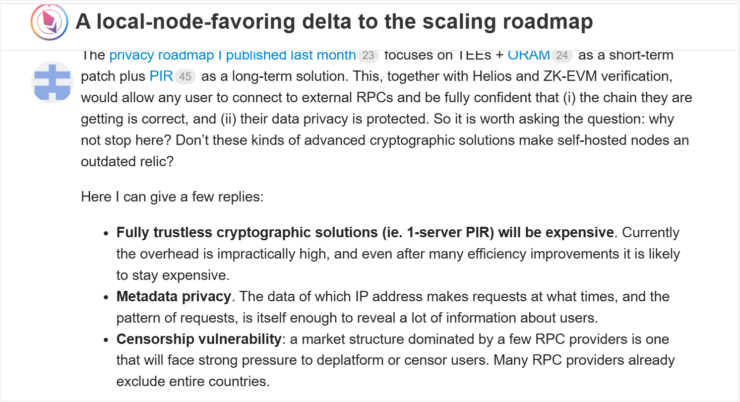Ethereum co-founder Vitalik Buterin is championing a new approach that could drastically reduce the technical demands of running an Ethereum node—making it more accessible to everyday users equipped with standard consumer devices.
In a recent post on the Ethereum Research blog, Buterin outlined a “lightweight, local-first” strategy that would shift how nodes sync with the network. Instead of downloading the entire blockchain—currently more than 1.3 terabytes—nodes could selectively sync only the data they need. This targeted approach would drastically cut storage requirements and ease the burden on users running full nodes at home.

Nodes play a crucial role in Ethereum’s ecosystem, helping validate transactions and maintain the network’s decentralized integrity. Buterin emphasized that running a local node isn’t just about performance—it’s also about trustless access to the blockchain, resistance to censorship, and preserving user privacy.
“it is valuable to have a full node so that you can have a local RPC server that you can use to read the chain in a trustless, censorship-resistant and privacy-friendly way.,” Buterin wrote.
This proposal not only supports Ethereum’s decentralization goals but also ties into its broader roadmap of making the network more efficient and scalable. By enabling more people to run nodes without needing enterprise-grade infrastructure, Ethereum could strengthen its base of independent validators and boost network resilience.
Partially Stateless Nodes Could Cut Resource Needs
In the research proposal, Buterin argued that full nodes—while essential to Ethereum’s decentralization—are increasingly expensive to run due to rising storage and bandwidth requirements, especially as the network scales and gas limits expand. These resource constraints, he noted, discourage everyday users from participating in node operation, potentially threatening Ethereum’s core values of censorship resistance and decentralization.
To address this, Buterin suggests a middle ground: partially stateless nodes. These lightweight nodes would validate blocks without maintaining the full Ethereum state or entire blockchain history. Instead, users could store only the parts of the chain that are personally relevant—such as their accounts, DeFi activity, or specific tokens—while skipping over unrelated data.
Design Offers Better Privacy, Modularity, and Local Control
This model enhances both privacy and local autonomy. Users could configure their nodes to serve and verify only selected data locally, while queries for external information would either fail or be rerouted via remote procedure call (RPC) providers.
Crucially, these nodes could validate blocks using cryptographic proofs without holding the full Merkle state tree. This makes them more lightweight while still preserving trustlessness. By decoupling data storage from validation, the proposal enables users to run secure nodes without the full burden of infrastructure or bandwidth requirements.
The stateless node concept also supports a more modular network architecture—allowing for flexible trade-offs between performance, decentralization, and privacy based on user preferences.
Supports Ethereum’s Roadmap for Scalability and Inclusion
Buterin’s proposal aligns closely with Ethereum’s broader roadmap, particularly its focus on making the network more scalable, decentralized, and accessible. The recently implemented Pectra upgrade—designed to improve transaction speed, cost efficiency, and staking mechanisms—already laid foundational work in this direction.
If adopted, lightweight nodes could help Ethereum accommodate millions of new users without sacrificing core decentralization principles. More accessible node operation would increase validator diversity, reduce reliance on centralized RPC providers, and support Ethereum’s long-term vision of a truly global, user-powered infrastructure.
Quick Facts
- Vitalik Buterin has proposed a lightweight, local-first node model to reduce storage and bandwidth barriers for Ethereum users.
- The idea of “partially stateless nodes” allows users to verify only data relevant to them while still validating blocks using cryptographic proofs.
- This approach could boost privacy, reduce reliance on full blockchain history, and lower the entry barrier for node participation.
- The design supports Ethereum’s decentralization goals and complements recent upgrades like Pectra, aimed at scaling and efficiency.





